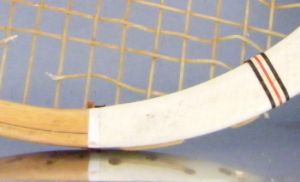When you think about registrar’s work I bet most of the time you think about fine arts, archaeological findings or fossils. Lesser known and recognized are sports collections and museums. But, hey, sports and museum? Sounds like a win-win to me. I was glad to meet Antony Aristovoulou who has worked for several sports collections. A registrar’s game seems to be always the same: sort, catalog, data base, crate, store. Not much of a surprise, you just play by the rules. But what happened to Antony was nothing like expecting a grass court and discovering it’s a clay court. It’s like expecting a 100-meter sprint and discovering on the day you show up for the match that it’s an Ironman and you are supposed to do it with your flip-flops on.
 My work with the Melbourne Cricket Club Museum/National Sports Museum collection relocation/registration/rehouse was coming to an end and I secured new work with Deakin University’s Centre for Leisure Management Research (CLMR) in December 2006. I was told that as of January 2007, Tennis Australia had a tennis heritage collection which needed to be relocated and registered. The whole kit and kaboodle. At this point I was not told that no foundation work had been made (i.e. off site facility, cms, shelving, etc…). Hell, the contract between the University and Tennis Australia (TA) hadn’t even been finalised yet! So, here I was all proud of myself, thinking I’d finish one job, have Xmas holidays, and after New Years, go straight into a new job. How wrong was I!
My work with the Melbourne Cricket Club Museum/National Sports Museum collection relocation/registration/rehouse was coming to an end and I secured new work with Deakin University’s Centre for Leisure Management Research (CLMR) in December 2006. I was told that as of January 2007, Tennis Australia had a tennis heritage collection which needed to be relocated and registered. The whole kit and kaboodle. At this point I was not told that no foundation work had been made (i.e. off site facility, cms, shelving, etc…). Hell, the contract between the University and Tennis Australia (TA) hadn’t even been finalised yet! So, here I was all proud of myself, thinking I’d finish one job, have Xmas holidays, and after New Years, go straight into a new job. How wrong was I!
Things slowly started getting off the ground from March ’07, where I was taken to a shipping container holding facility. Basically the whole collection was contained in this container – direct from California, U.S.A. This was the private collection of a German ex-pat named Rolf Jaeger, who exhibited them in a private museum in California. They were bought by the then President of TA, Mr. Geoff Pollard, in the hope of kick-starting a Tennis Australia heritage collection, for a new tennis museum based at Melbourne Park. This Jaeger Collection was to complement the historical artefacts held in the offices and storerooms of Melbourne Park. Australia was the only Grand Slam nation which did not have a Grand Slam tennis museum. All the artefacts were stuffed into the container and I knew straight away there be some casualties. My jaw was agape and I was wondering what I had just gotten myself into.
Anyway, my job was not just to do all of the above, but I had to source a storage facility, computer hardware, imaging software and cms, photography equipment, advise on security, shelving. etc…
I got all this done, had the shipping container delivered, and over the course of a few months, slowly sorted through the items. Money became scarce after a short while – I got what I wanted with the facility, computer, cms, and photography equipment, but I didn’t get what I wanted with regards to rehousing materials (acid free boxes, etc..) and shelving ( I got some, but not enough to satisfactorily house all items safely). For many items – the hundreds of racquets in particular – I had to store these in large acrylic containers (with cling wrap across the top) which came in the shipping container, each sitting on wooden pallets. :-/
Nevertheless, everything was tagged, registered, catalogued (Vernon CMS), given locations, photographed and image linked, and, of course, rehoused (to the best of my abilities).
I conducted comprehensive damage reports for the unprotected and minimally protected items coming out of the shipping container, and that was pretty much it.
Oh, no, not quite. I also had to (also unbeknownst to me when I began) manage TA’s non collection excess furniture and Australian Open equipment. These took up a huge amount of the storage space, and it took me months to rearrange all this stuff to condense it and maximise space for the collection, AND, manage it in a way so any dirt and dust from this impacted on the collection as little as possible.
Well, that’s it – as far as I can remember at the time of writing. I don’t know what has happened to the majority of the collection since I finished this project in April 2009, but around a year later, I did see that some of the artefacts I worked with had been loaned to the Kooyong Tennis Club (the former home of the Australian Open), and that was good to see. At least some of the gems i worked with were getting some show time! 🙂
Text: Antony Aristovoulou
This post is also available in Russian translated by Helena Tomashevskaya.